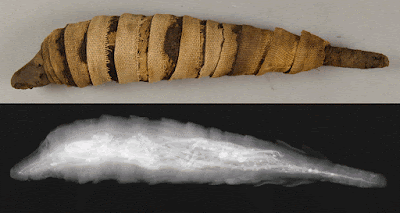 |
| Brooklyn Museum, 30 B.C.E. – 50 C.E. |
Even people who really love Egyptology and know a lot about ancient mummies might be curious about this little bundle of linen. It's only about nine inches (21 centimeters) long, and less than two inches (3.5 centimeters) at its thickest point. What in the world could be mummified in such a small package?
The answer to this question can be found using modern technology! Modern scientists prefer to use non-destructive methods to learn more about mummies from the past. Instead of cutting or damaging their wrappings, they instead put them into a medical scanner.
Here's another mummy bundle with a very similar size, shape and date. When we look inside...what do we see?
 |
| Penn Museum, E12435: mummy from the side, paired with radiograph |
Most of us are not experts when it comes to mummies OR small mammals, but zooarchaeologist Kate Moore had the answer. It was the teeth that were the real give-away--this was a mummy of one of the world's smallest mammals, the Egyptian sacred shrew.
 |
| Dr. Moore and a shrew skull |
 |
| The Egyptian pygmy shrew (Image Bibliotheca Alexandrina) |
 |
| Wikipedia image of Etruscan shrew. |
Shrews, although they are very tiny, are incredibly fierce animals! And because they are such mighty mites, they are capable of killing snakes and destroying their eggs. In ancient Egypt, the shrews were representatives of the god Horus, the protector of the Sun. By day, Horus has the form of a Falcon, but by night, Horus takes the form of a shrew or an Egyptian mongoose, to keep up His eternal battle against the cobras and crocodiles that threaten the Sun on its cosmic journey.
___
WANT TO LEARN MORE?
Animal mummies are a fascinating topic, and there are lots of great resources where you can learn more about them.
SOULFUL CREATURES: ANIMAL MUMMIES OF ANCIENT EGYPT is available on Amazon. But if you can't afford your own copy, you might find it in your library. If your library doesn't have a copy--you could always ask them to buy one for the collection!
National Geographic Magazine also has a gallery of ancient Egyptian animal mummies, which has beautiful images. It is connected to an article which was published in the magazine in November 2009. Does your library have back issues of National Geographic?
The Penn Museum Artifact Lab has a blog where scientist Molly Gleeson publishes posts about the lab's study of animal mummies using modern scanning technology.
The New York Times ran an interesting article about the Soulful Creatures Exhibit at the Brooklyn Museum, which includes facts and interviews with scientists who study Egyptian animal mummies.
___
ABOUT THE AUTHOR
Arinn Dembo is a professional science fiction writer and software developer working in Vancouver, BC. She has degrees in Anthropology and Classical and Near Eastern Archaeology, and volunteers as a science educator at Vancouver's The Learnary, where she teaches an ongoing series of workshops called Gothic Science.
No comments:
Post a Comment